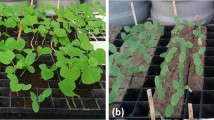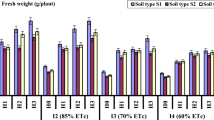Abstract
Purpose
Effective management of the issues related to increasing water scarcity in semi-arid regions needs special attention to minimize the negative influence of water stress conditions and prevent soil degradation to ensure global food security.
Methods
The present study develops an eco-friendly, low-cost superabsorbent hydrogel composite (SHC) through recycling natural fibre using graft polymerization method. Effectiveness of the synthesized SHC for conservation of irrigation water was investigated by measuring its water absorbency in different salt, and pH solutions, reswelling capacity, and the soil–water retention curve (SWRC) of SHC amended soil.
Results
The synthesized SHC showed water absorbency of 342 g/g in distilled water, indicating its suitability for agricultural application. The SHC showed excellent re-swelling characteristics for more than eight alternate wetting–drying cycles. The sensitivity of SHC to different inorganic salt solutions was investigated, which showed its water absorbency higher than 90 g/g at the maximum salinity level permitted for plant growth. The addition of SHC in silt loam soil showed an increase in water availability of 56%, 81%, and 125%, with the SHC concentrations of 0.1%, 0.2%, and 0.4%, respectively.
Conclusion
The addition of SHC had reduced the irrigation water requirement by 29% as compared to bare soil at an optimum application rate of 0.2%. The study promotes the use of synthesized SHC for the conservation of irrigation water, as well as soil ecosystem, with an additional advantage of contributing to the mass utilization of waste materials.
Graphical Abstract










Similar content being viewed by others
Data Availability
The datasets generated during and/or analyzed during the current study are available from the corresponding author on reasonable request.
References
Chartzoulakis, K., Bertaki, M.: Sustainable water management in agriculture under climate change. Agri. Agric. Sci. Procedia 4, 88–98 (2015). https://doi.org/10.1016/j.aaspro.2015.03.011
Xu, C., McDowell, N.G., Fisher, R.A., Wei, L., Sevanto, S., Christoffersen, B.O., Weng, E., Middleton, R.S.: Increasing impacts of extreme droughts on vegetation productivity under climate change. Nat. Clim. Chang. 9(12), 948–953 (2019). https://doi.org/10.1038/s41558-019-0630-6
Geng, S.M., Yan, D.H., Zhang, T.X., Weng, B.S., Zhang, Z.B., Qin, T.L.: Effects of drought stress on agriculture soil. Nat. Hazards 75(2), 1997–2011 (2015). https://doi.org/10.1007/s11069-014-1409-8
Paneque, P.: Drought management strategies in Spain. Water 7, 6689–6701 (2015). https://doi.org/10.3390/w7126655
Saha, A., Sekharan, S., Manna, U.: Superabsorbent hydrogel (SAH) as a soil amendment for drought management: a review. Soil and Tillage Research 204, 104736 (2020). https://doi.org/10.1016/j.still.2020.104736
Al-Jabari, M., Ghyadah, R.A., Alokely, R.: Recovery of hydrogel from baby diaper wastes and its application for enhancing soil irrigation management. J. Environ. Manage. 239, 255–261 (2019). https://doi.org/10.1016/j.jenvman.2019.03.087
Sekharan, S., Gadi, V.K., Bordoloi, S., Saha, A., Kumar, H., Hazra, B., Garg, A.: Sustainable geotechnics: a bio-geotechnical perspective. Front. Geotech. Eng., 313–331 (2019). Springer, Singapore. https://doi.org/10.1007/978-981-15-0886-8_15
Feng, D., Bai, B., Ding, C., Wang, H., Suo, Y.: Synthesis and swelling behaviors of yeast-g-poly (acrylic acid) superabsorbent co-polymer. Ind. Eng. Chem. Res. 53(32), 12760–12769 (2014). https://doi.org/10.1021/ie502248n
Saha, A., Rattan, B., Sekharan, S., Manna, U.: Quantifying the interactive effect of water absorbing polymer (WAP)-soil texture on plant available water content and irrigation frequency. Geoderma 368, 114310 (2020). https://doi.org/10.1016/j.geoderma.2020.114310
Koupai, J.A., Eslamian, S.S., Kazemi, J.A.: Enhancing the available water content in unsaturated soil zone using hydrogel, to improve plant growth indices. Ecohydrol. Hydrobiol. 8(1), 67–75 (2008). https://doi.org/10.2478/v10104-009-0005-0
Spagnol, C., Rodrigues, F.H., Pereira, A.G., Fajardo, A.R., Rubira, A.F., Muniz, E.C.: Superabsorbent hydrogel composite made of cellulose nanofibrils and chitosan-graft-poly (acrylic acid). Carbohyd. Polym. 87(3), 2038–2045 (2012). https://doi.org/10.1016/j.carbpol.2011.10.017
Guilherme, M.R., Aouada, F.A., Fajardo, A.R., Martins, A.F., Paulino, A.T., Davi, M.F., Rubira, A.F., Muniz, E.C.: Superabsorbent hydrogels based on polysaccharides for application in agriculture as soil conditioner and nutrient carrier: A review. Eur. Polymer J. 72, 365–385 (2015). https://doi.org/10.1016/j.eurpolymj.2015.04.017
Zhang, L., Loh, K.C., Sarvanantharajah, S., Shen, Y., Tong, Y.W., Wang, C.H., Dai, Y.: Recovery of nitrogen and phosphorus nutrition from anaerobic digestate by natural superabsorbent fiber-based adsorbent and reusing as an environmentally friendly slow-release fertilizer for horticultural plants. Waste and Biomass Valorization 11(10), 5223–5237 (2020). https://doi.org/10.1007/s12649-019-00915-3
Thakur, V.K., Thakur, M.K.: Processing and characterization of natural cellulose fibers/thermoset polymer composites. Carbohyd. Polym. 109, 102–117 (2014). https://doi.org/10.1016/j.carbpol.2014.03.039
Wattie, B., Dumont, M.J., Lefsrud, M.: Synthesis and properties of feather keratin-based superabsorbent hydrogels. Waste and Biomass Valorization 9(3), 391–400 (2018). https://doi.org/10.1007/s12649-016-9773-0
de Vasconcelos, M.C., Gomes, R.F., Sousa, A.A., Moreira, F.J., Rodrigues, F.H., Fajardo, A.R., Neto, L.G.P.: Superabsorbent hydrogel composite based on starch/rice husk ash as a soil conditioner in melon (cucumis melo L.) seedling culture. J. Polym. Environ. 28(1), 131–140 (2020). https://doi.org/10.1007/s10924-019-01593-x
Abou-Baker, N.H., Ouis, M., Abd-Eladl, M., Ibrahim, M.M.: Transformation of lignocellulosic biomass to cellulose-based hydrogel and agriglass to improve beans yield. Waste Biomass Valor. 11(7), 3537–3551 (2020). https://doi.org/10.1007/s12649-019-00699-6
Dhar, S.A., Sakib, T.U., Hilary, L.N.: Effects of pyrolysis temperature on production and physicochemical characterization of biochar derived from coconut fiber biomass through slow pyrolysis process. Biomass Conv. Bioref. (2020). https://doi.org/10.1007/s13399-020-01116-y
Prakongkep, N., Gilkes, R.J., Wiriyakitnateekul, W.: Forms and solubility of plant nutrient elements in tropical plant waste biochars. J. Plant Nutr. Soil Sci. 178(5), 732–740 (2015). https://doi.org/10.1002/jpln.201500001
ASTM D854: Standard test method for specific gravity of soil solids by water pycnometer. ASTM international: WestConshohocken. PA, USA (2014)
ASTM D4318: Standard test methods for liquid limit, plastic limit, and plasticity index of soils. ASTM international: WestConshohocken. PA, USA (2017)
ASTM D7503: Standard Test Method for Measuring the Exchange Complex and Cation Exchange Capacity of Inorganic Fine-Grained Soils. ASTM international: West Conshohocken. PA, USA (2018).
Bao, Y., Ma, J., Li, N.: Synthesis and swelling behaviors of sodium carboxymethyl cellulose-g-poly (AA-co-AM-co-AMPS)/MMT superabsorbent hydrogel. Carbohyd. Polym. 84(1), 76–82 (2011). https://doi.org/10.1016/j.carbpol.2010.10.061
Zhang, M., Cheng, Z., Zhao, T., Liu, M., Hu, M., Li, J.: Synthesis, characterization, and swelling behaviors of salt-sensitive maize bran–poly (acrylic acid) superabsorbent hydrogel. J. Agric. Food Chem. 62(35), 8867–8874 (2014). https://doi.org/10.1021/jf5021279
Saha, A., Sekharan, S., Manna, U.: Evaluation of capacitance sensor for suction measurement in silty clay loam. Geotech. Geol. Eng. 38(4), 4319–4331 (2020). https://doi.org/10.1007/s10706-020-01297-3
Andry, H., Yamamoto, T., Irie, T., Moritani, S., Inoue, M., Fujiyama, H.: Water retention, hydraulic conductivity of hydrophilic polymers in sandy soil as affected by temperature and water quality. J. Hydrol. 373(1–2), 177–183 (2009). https://doi.org/10.1016/j.jhydrol.2009.04.020
Agaba, H., Baguma Orikiriza, L.J., Osoto Esegu, J.F., Obua, J., Kabasa, J.D., Hüttermann, A.: Effects of hydrogel amendment to different soils on plant available water and survival of trees under drought conditions. Clean-Soil, Air, Water 38(4), 328–335 (2010). https://doi.org/10.1002/clen.200900245
Dorraji, S.S., Golchin, A., Ahmadi, S.: The effects of hydrophilic polymer and soil salinity on corn growth in sandy and loamy soils. Clean-Soil, Air, Water 38(7), 584–591 (2010). https://doi.org/10.1002/clen.201000017
Louf, J.F., Lu, N.B., O’Connell, M.G., Cho, H.J., Datta, S.S.: Under pressure: Hydrogel swelling in a granular medium. Sci. Adv. 7(7), 2711 (2021). https://doi.org/10.1126/sciadv.abd2711
Misiewicz, J., Lejcuś, K., Dąbrowska, J., Marczak, D.: The characteristics of absorbency under load (AUL) for superabsorbent and soil mixtures. Sci. Rep. 9(1), 1–9 (2019). https://doi.org/10.1038/s41598-019-54744-4
Lejcuś, K., Śpitalniak, M., Dąbrowska, J.: Swelling behaviour of superabsorbent polymers for soil amendment under different loads. Polymers 10(3), 271 (2019). https://doi.org/10.3390/polym10030271
Abraham, E., Deepa, B., Pothen, L.A., Cintil, J., Thomas, S., John, M.J., Anandjiwala, R., Narine, S.S.: Environmental friendly method for the extraction of coir fibre and isolation of nanofibre. Carbohyd. Polym. 92(2), 1477–1483 (2013). https://doi.org/10.1016/j.carbpol.2012.10.056
Saha, A., Sekharan, S., Manna, U., Sahoo, L.: Transformation of non-water sorbing fly ash to a water sorbing material for drought management. Sci. Rep. 10(1), 1–16 (2020). https://doi.org/10.1038/s41598-020-75674-6
Zhang, J.P., Zhang, F.S.: Recycling waste polyethylene film for amphoteric superabsorbent resin synthesis. Chem. Eng. J. 331, 169–176 (2018). https://doi.org/10.1016/j.cej.2017.08.058
Cândido, J.D.S., Leitao, R.C., Ricardo, N.M., Feitosa, J.P., Muniz, E.C., Rodrigues, F.H.: Hydrogels composite of poly (acrylamide-co-acrylate) and rice husk ash I Synthesis and characterization. J. Appl. Polym. Sci. 123(2), 879–887 (2012). https://doi.org/10.1002/app.34528
Munns, R., Tester, M.: Mechanisms of salinity tolerance. Annu. Rev. Plant Biol. 59, 651–681 (2008). https://doi.org/10.1146/annurev.arplant.59.032607.092911
Zhu, J.K.: Plant salt stress. In: Encyclopedia of Life Sciences, Wiley (2007)
Mahdavinia, G.R., Pourjavadi, A., Hosseinzadeh, H., Zohuriaan, M.J.: Modified chitosan superabsorbent hydrogels from poly (acrylic acid-co-acrylamide) grafted chitosan with salt-and pH-responsiveness properties. Eur. Polymer J. 40(7), 1399–1407 (2004). https://doi.org/10.1016/j.eurpolymj.2004.01.039
Fernández, F.G., Hoeft, R.G.: Managing soil pH and crop nutrients. Illinois Agronomy Handbook 24, 91–112 (2009)
Wei, Y., Durian, D.J.: Effect of hydrogel particle additives on water-accessible pore structure of sandy soils: A custom pressure plate apparatus and capillary bundle model. Phys. Rev. E 87(5), 053013 (2013). https://doi.org/10.1103/PhysRevE.87.053013
Rahmati, M., Pohlmeier, A., Abasiyan, S.M.A., Weihermüller, L., Vereecken, H.: Water Retention and Pore Size Distribution of a Biopolymeric-Amended Loam Soil. Vadose Zone Journal 18(1), 1–13 (2019). https://doi.org/10.2136/vzj2018.11.0205
Colman, E.A.: A laboratory procedure for determining the field capacity of soils. Soil Sci. 63(4), 277–284 (1947)
ASTM D422–63: Standard test method for particle-size analysis of soils. ASTM International: West Conshohocken. PA, USA (2007)
ASTM D2487: Standard practice for classification of soils for engineering purposes (unified soil classification system). ASTM international: West Conshohocken. PA, USA (2011)
Acknowledgements
The authors thankfully acknowledge the Central Instrument Facility (CIF) and Department of Chemistry, Indian Institute of Technology Guwahati for providing the necessary support required for this research work.
Funding
The authors received no specific funding for carrying out this research work.
Author information
Authors and Affiliations
Contributions
Conceptualization: AS, SS; Material preparation: AS; Formal analysis and investigation: AS, CBG; Writing—original draft preparation: AS; Writing—review and editing: SS; Supervision: SS.
Corresponding author
Ethics declarations
Conflict of interest
On behalf of all authors, the corresponding author states that there is no conflict of interest.
Additional information
Publisher's Note
Springer Nature remains neutral with regard to jurisdictional claims in published maps and institutional affiliations.
Rights and permissions
About this article
Cite this article
Saha, A., Gupt, C.B. & Sekharan, S. Recycling Natural Fibre to Superabsorbent Hydrogel Composite for Conservation of Irrigation Water in Semi-arid Regions. Waste Biomass Valor 12, 6433–6448 (2021). https://doi.org/10.1007/s12649-021-01489-9
Received:
Accepted:
Published:
Issue Date:
DOI: https://doi.org/10.1007/s12649-021-01489-9




